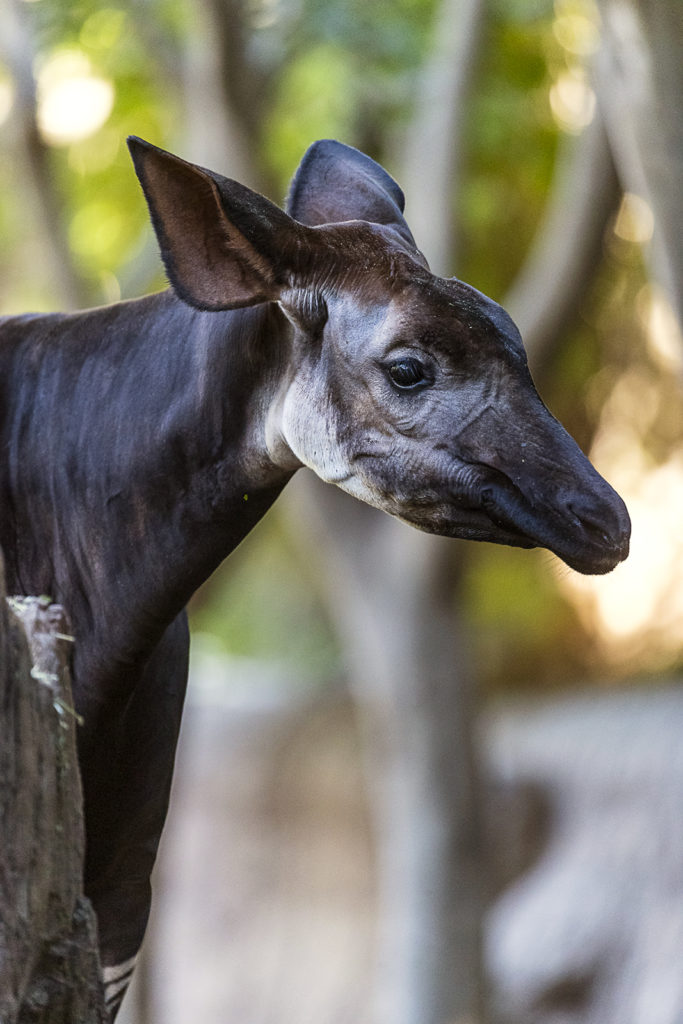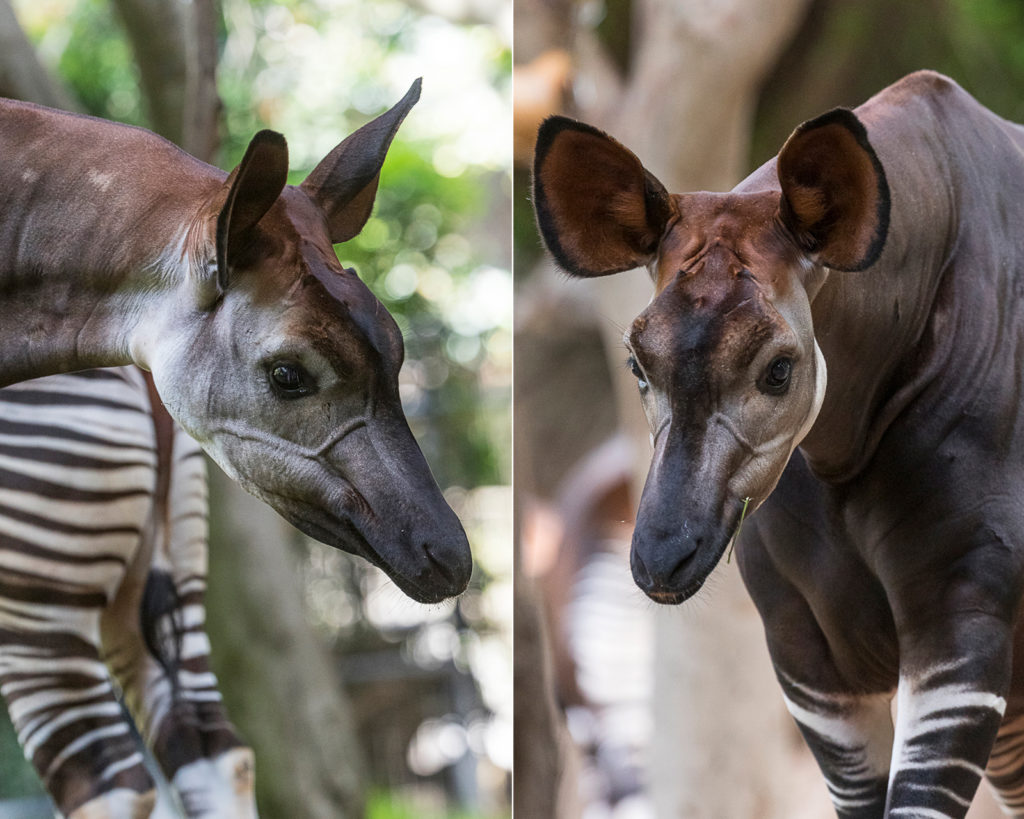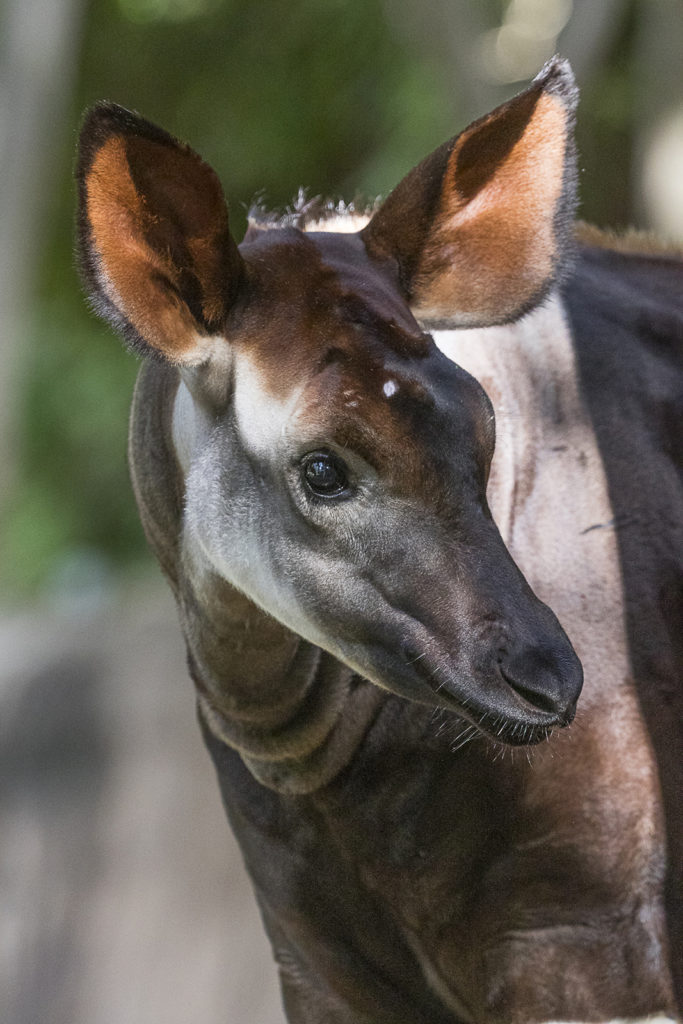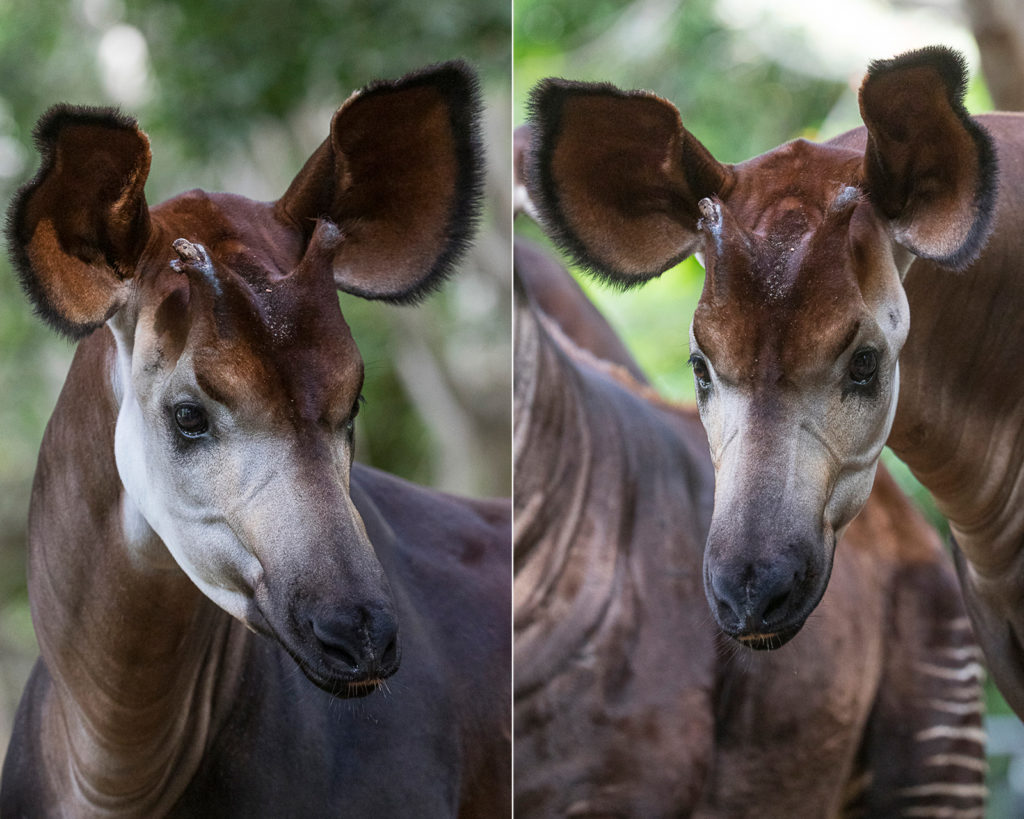
A new dynamic is taking place in the Ituri Forest on Hippo Trail at the San Diego Zoo. There is a "herd" of four okapis living together, a unique sight as they are thought to be solitary animals. This grouping is somewhat unheard of in the only place okapis are naturally found in the wild, the tropical rain forests of the Democratic Republic of Congo (DRC). There have been some instances where researchers have observed pairs of females together or a female and calf, but now those who venture to the Zoo’s okapi habitat will be able to see some interesting behaviors with this unconventional group. Let’s meet them!
Safarani, a true matriarch, is the glue that binds them. At 26 years young, she’s a mother and grandmother, and the group’s nurturer, always there to keep an eye on the calves—whether they are hers or not. She was the first okapi Mosi met, other than his mother, and she immediately took on an aunt-like role in his life. She would help clean him, show him around the habitat, and to this day scolds him with a gentle kick or two if he gets too pushy. Safarani taught Mosi valuable life lessons early on, which have probably helped him easily fit in with her blood relatives, Subira and Elombe.

Subira, the other female okapi, is Safarani’s calf born six years ago. She’s also a first-time mom to Elombe. Subira was the first okapi I had the privilege to see born, and watching her become a mom has been incredible. She had the best teacher in Safarani and has also been lucky enough to have her mom take over calf-sitting when she needs some space.

Elombe (aka Eli) is Subira’s eight-month-old son, and is quite a character! He often has what can only be described as an "angry" look about him, mostly when he is processing or thinking about something. It’s his prominent dark eyebrows that give him that look. While all the okapis have those eyebrow-like markings, Eli’s are a bit more expressive. Our little thinker has been infatuated with Mosi since the first time he met him, separated by a howdy fence. Now that they share the same space, the boys are often seen interacting and nibbling on browse together.

Completing our herd is two-year-old Mosi. For a time, he was separated from Subira and Elombe by a howdy fence in the exhibit. We needed to wait and receive approval from the Species Survival Plan (SSP) to allow this coming-of-age male to be in the same space as a female he could potentially breed with. Since they are not related and approval was granted, we now let them share space. If we are lucky, these two will naturally take their relationship to the next level. Mosi could still be a bit young for such a pairing, however the youngest male documented in siring a calf was two years old.

The steps taken to becoming a herd began months ago, using a common technique when introducing animals called a "howdy." This is a place where animals can see each other and, in this case, touch each other over the top of a fence yet still be protected from possible aggression like kicking. It is important to mention the touching over the fence top because in this instance as I believe this sealed their interactions as positive ones.
Okapis are relatives of the giraffe. Their most recognizable similarity is a long, prehensile tongue—which, in addition to feeding, is used to groom one another, helping to build a positive relationship and bond between them. Keepers observed, on a daily basis, these grooming sessions between Mosi and the others he was separated from, but more importantly with Elombe.
Since we knew that Mosi, Safarani, and Subira lived well together as a group, the only wild card was Elombe. Many questions arose from our animal care team prior to the day we were to open the howdy. With Mosi coming of age, would he view this young male as a threat to "his" females? Would Elombe get hurt if Mosi was more interested in Subira? Elombe exhibited a tough attitude by posturing and tail swishing toward Mosi occasionally at the howdy fence. Would he continue to act that way and possibly suffer an injury, since Mosi outweighs him by about 200 pounds? The only way we were going to answer those questions was to allow them access, while keepers stood by at the ready to separate if needed. Keeper staff work with okapis at times in a free-contact setting, meaning we go into the same space to build our own working relationships, to add fresh browse and enrichment to their habitat, and for wellness checks.
The day arrived for them to be together without barriers. Animal care staff met to discuss the shift order, where we would be positioned, and what safety measures and gear were to be used if we needed to intervene. Thankfully, our preparation paid off. We shifted Safarani first, then Mosi, and finally added Subira and Elombe. Doing so, we set everyone up to successfully become a herd, and no intervention was needed!
Elombe, being a young and curious kid with an attitude, made a beeline for Mosi, who was immediately bumped and pushed by the feisty tyke. At first, Mosi tried to trot away, but that only made Eli more persistent—like a game. Finally, those lessons Safarani taught Mosi came in handy as he gently kicked at Eli to establish a boundary and instruct him be a bit more respectful of his elder. There are still times this interaction occurs (kids will be kids, and lessons need to be reinforced), but if Safarani notices that anyone is getting a bit carried away, she calmly walks toward them—it seems to get the point across, and they settle down.
Mosi did have a period of time where he was quite focused on Subira, but Eli didn’t get in the way; instead, he spent some quality time with his grandma. We have yet to observe breeding between Mosi and Subira, but if that were to occur, it seems that Elombe would step aside, and Mosi hasn’t shown signs of aggression toward him. Of course, behaviors and dynamics change constantly, so animal care staff are monitoring them closely and are ready to change up the herd, if need be. But in the meantime, we are enjoying every minute observing the complex dynamics and behaviors being exhibited. I encourage all visitors to take some extra time and observe this herd on Hippo Trail at the San Diego Zoo. You might even spot a small species of antelope, known as a black duiker, that shares their habitat.
Jen Chapman is a senior keeper at the San Diego Zoo. Read her previous blog, Neighborhood Watch, Hippo Style




